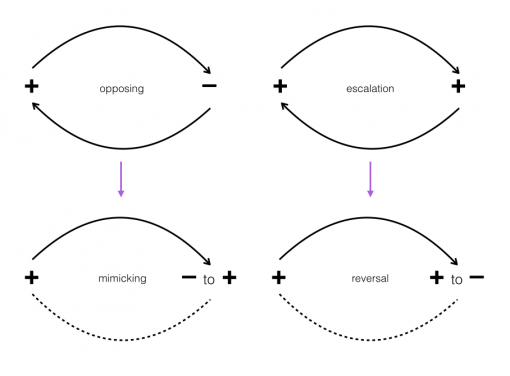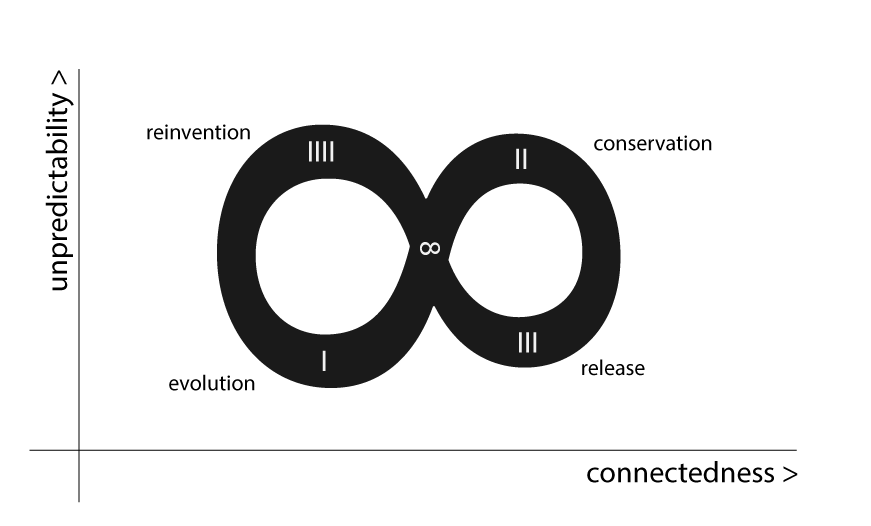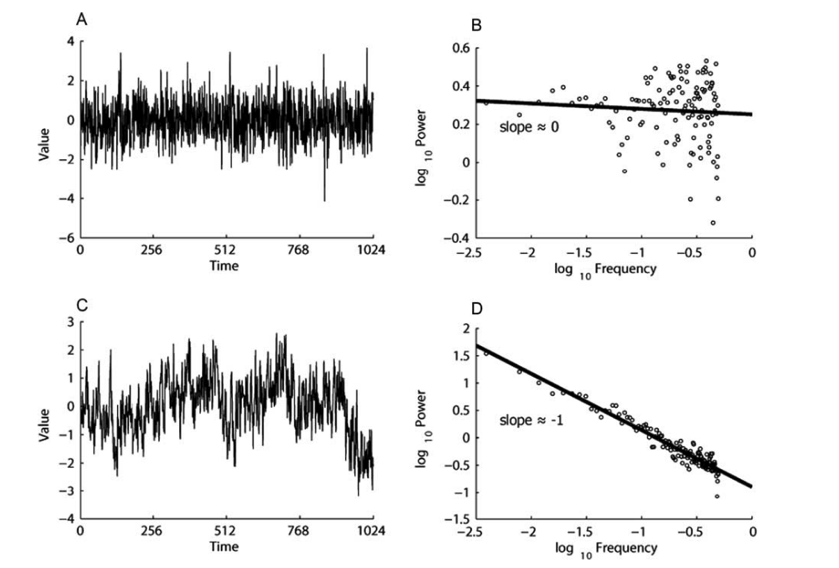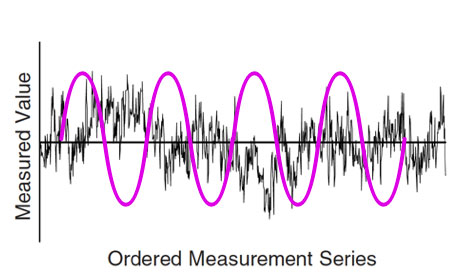Materials: Embodied Experience of Dynamical Systems
Here’s a collection of some interesting materials that we used in the ∞OS activation program hosted in Berlin in March 2019.
Slideshow
This slideshow was used in the workshop and contains the main ideas from the session with images and references.
Synopsis
The main focus of this working session was to explore and practice the link between the complex systems theory and our day-to-day behavior. Specifically, we were interested to see how various dynamical patterns can be modulated both on the level of the body as well as intersubjective relations and what the outcomes of this modulation may be.
Case 1: Feedback Loops — the Dynamics of Tension and Release
The first case is a simple scenario of two parties engaged in a feedback loop inter~action. There are two different types of influence possible in this constellation: a symmetric one and a complimentary one.
In the symmetric relation if one side escalates (increases the tension), the other one responds with even more escalation (e.g. competition — more tension).
In the complimentary relation, if one side escalates (more tension), the other one de-escalates (e.g. dominance – tension and submission – release).
If the both processes are left unchecked, the system will eventually change its state or destroy itself. This might be a desired outcome but there are also situations where we need to maintain a certain degree of stability.

If we are able to identify the type of relationship we are engaged in, we can steer and modulate the dynamics of the whole system. For example, if we are engaged in a symmetric feedback loop, we can prevent it from escalating further by reversing the predictable response and de-escalating in response to the other side’s escalating (small change / reversal).
Another way is to recontextualize the loop by introducing an unexpected behavior into the dynamic pattern. That is how humor (smiling) works: not only because it is a way to release the tension, but also because it provides a meta-perspective that allows one to disengage from the feedback loop.
A “crazy” response is another way to “hack” the loop and to prevent it from spiralling further. We call this strategy a contextual shift.
In eightos we have special exercises that allow us to observe and to practice these disengagement patterns, so that they get recorded into our system on the level of reflexes. Here is a good example of an exercise that plays with the tension / release dynamics allowing one to circumvent the feedback loop established.
A similar approach can also be used in other contexts. To take an example of the arms race from history: when the US and the USSR reached the peak of their arsenal during the Cold War, the US then started to gradually decrease its output. This, in turn, also lead the USSR to de-escalate.
The same approach can be used in music, where there’s a constant interplay between the build-up of tension and release. For example, in techno music a musician constructs a context with a gradual build-up of tension through increasing the presence of high frequency and reducing the low frequency (complimentary feedback loop). Once the tension has built up sufficiently (a “break”), the low frequency (the beat) is released to reverse the feedback loop and to “reboot” the system. Same strategy is used when the development of a track is punctuated with a chorus. These kind of general shifts can be combined with the smaller shifts (build-up / breaking down), which are often used in music.
A well-known anthropologist Gregory Bateson in his book “Steps to An Ecology of Mind” has found that the societies which have embedded into the culture the ability to shift the feedback loop dynamics tend to be more stable and avoid wars. This does not happen through the complete eradication of conflict (symmetric tension), but, rather, through modulated generation of conflict only to then release it and to allow the system to reconstruct itself. A similar approach is proposed in Panarchy: a system that proposes to embrace the periods of growth / decline / restructuring in the economy and politics.

Case 2: Chaotic Dynamics, “Pink” 1/f Noise and Variability
Once we get an embodied experience of the feedback loops, we can zoom out and study the dynamics of variability from a meta perspective.
In the previous section we talked about an interplay between the tension and release as a way to modulate feedback dynamics. The ability to alternate between patterns (escalation/deescalation) and to shift between contexts allows us to, on the one side, ensure that we can both build something up (self-reinforcing feedback loop), while also having the concrete mechanisms to ensure that it does not grow out of self-sustainable zone (recontextualization).
The next question is: how can we modulate this dynamics itself? How often should these changes in the tension/release and the recontextualization shifts take place?
This, of course, depends on the objective. There are studies (see references below) that show that systems in the most adaptive states exhibit so-called chaotic, 1/f noise dynamics. “Chaos” in this context does not mean disorder. In complex system science chaotic state is unpredictable, but highly organized. It’s not easily possible to say what’s going to happen next, but there’s a certain pattern that emerges over a period of time. This pattern is characterized by a lot of small changes with a small amplitude and a few, but significant number of big changes with a large amplitude.

In the context of tension/release dynamics this means that in order to stay adaptive and ready to external change we need to maintain a certain kind of dynamics where we make frequent small changes to tension/release and occasionally introduce bigger changes to the dynamics of interaction.
It has also been demonstrated (see the references below) that various pathological states are associated with deviations from this dynamics. For example, a state of anxiety on the level of the body movement is associated with the whitening of the signal (see image A on the figure below). That means the movements become more random: there’s almost the same number of small changes as there are the big ones. Which makes sense: shifting the state too often might make you anxious or excited at best.

At the same time, pure chaotic pattern of change alone may render a system unstable. It has been demonstrated that stable systems tend to combine a sustained rhythm with chaotic dynamics. For example, in the study of mood shifts over time it was found that a “healthy” mental state (adaptive and relatively stable) combines circadian rhythm with 1/f dynamics. The same pattern of dynamic change was also observed in a healthy heart beat. Overall, chaos combined with rhythm seems to be correlated with a more stable, adaptable, “healthy” state.
In eightos practice we learn to modulate the movement that has chaotic, metastable 1/f properties while also maintaining a constant rhythm primarily through breathing. Outside of the physical context this can be realized through a special schedule which combines frequent small shifts (e.g. agile development patterns, role-based teams) with occasional changes in pattern (e.g. changing the strategy after a feedback session) with a certain circadian-rhythm based consistency (e.g. month-long iterative cycles). We do this by introducing the patterns of action that combine frequent small changes with the less frequent big shifts (cross-contextual or within the same context) and with a constant rhythm in the background. This can be applied in the realm of movement, intersubjective relations, project management (e.g. holocracy role-based circles), making music, drawing, etc. Such approach introduces a certain kind of variability, which produces metastable states through the modulated dynamics.

Videos
Here are some videos you might find interesting below. You can also see the whole playlist on YouTube. Don’t forget to subscribe to the ∞OS channel!
Evolution of a Cell:
Nice movement physicality that we also try to cultivate with ∞OS…
Street Flights
Notice how immobility makes people much more vulnerable in unexpected situations. When they move, the chances to avoid / respond are much higher. Also, very hard to predict that something will happen, so it’s important to learn how to receive.
Our Interview with Mayor Komarov (Systema practitioner based in Voronezh, Russia)
The importance of physical practice for learning:
Pain as a training device:
More in our interviews with Mayor Komarov in this playlist
∞OS Drills and Procedures
Assimilation > Redirection:
Getting out from a difficult situation (modularity):
More videos in this ∞OS Playlist
Natural Movement / Our Interview with Imre Thormann (Noguchi Taiso & Butoh Dancer)
Spirals and Waves in the Body:
Dance and the Inner Beauty:
More interviews with Imre Thormann in our interview on YouTube
Research Papers
The last page of the slideshow has many different references. Here are my favorite papers from the bunch with the links to PDFs. Feel free to add yours!
A great paper on robustness and resilience (about modularity etc.)
- Kitano, H. (2004). Biological robustness. Nature Reviews. Genetics, 5(11), 826–37
A more or less simple explanation of scale-free phenomena (1/f “pink” noise or chaos):
- Bak, P., Tang, C., & Wiesenfeld, K. (1987). Self-organized criticality: An explanation of the 1/ f noise. Physical Review Letters, 59(4), 381–384.
Two papers on how our body naturally moves in 1/f “pink” noise fractal chaotic pattern:
- D’Mello, S., Dale, R., & Graesser, A. (2011). Disequilibrium in the mind, disharmony in the body. Cognition & Emotion, 00(00), 1–13.
- Yamada, N. (1995). Posture as a Dynamic Stable State of a Body. Research and Clinical Center for Child Development.
Chaotic “fractal” dynamics in robots and movement:
- Matthey, L., Righetti, L., & Ijspeert, A. J. (2008). Experimental study of limit cycle and chaotic controllers for the locomotion of centipede robots. In 2008 IEEE/RSJ International Conference on Intelligent Robots and Systems (pp. 1860–1865). Nice: IEEE.
Very interesting work on nonlinearity of the brain, psychology and perception:
- Rabinovich, M. I., Huerta, R., Varona, P., & Afraimovich, V. S. (2008). Transient cognitive dynamics, metastability, and decision making. PLoS Computational Biology, 4(5)
- Bystritsky, a, Nierenberg, a a, Feusner, J. D., & Rabinovich, M. (2012). Computational non-linear dynamical psychiatry: A new methodological paradigm for diagnosis and course of illness. Journal of Psychiatric Research, 46(4), 428–435.
Plus my own research on the subject:
- Paranyushkin D (2012). Metastability of Cognition in the Body-Environment Network. Nodus Labs
Books:
These are two very good books, especially the Gregory Bateson one.
Gregory Bateson is talking about ecological patterns of interaction using the example of societies, tribes and groups
- Steps to an Ecology of Mind, Gregory Bateson
On venture fiction, cognitive stimulants and body-mind operating systems
- Special Agent’s Manual (preview)





Photos by Nailya Bikmurzina




